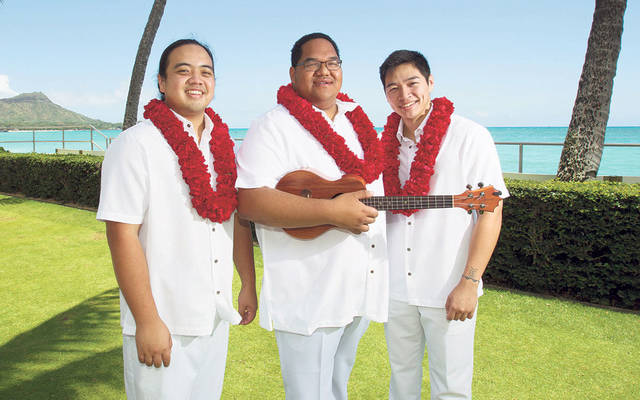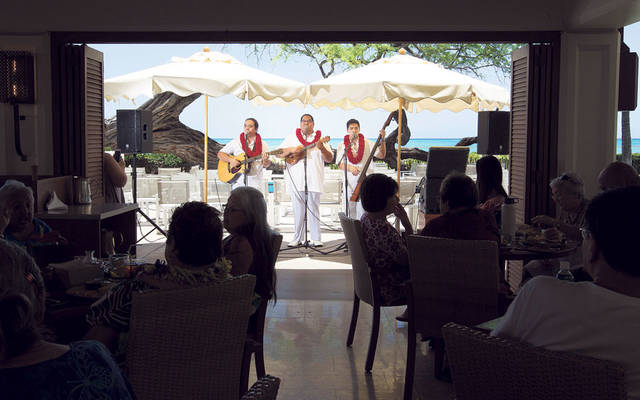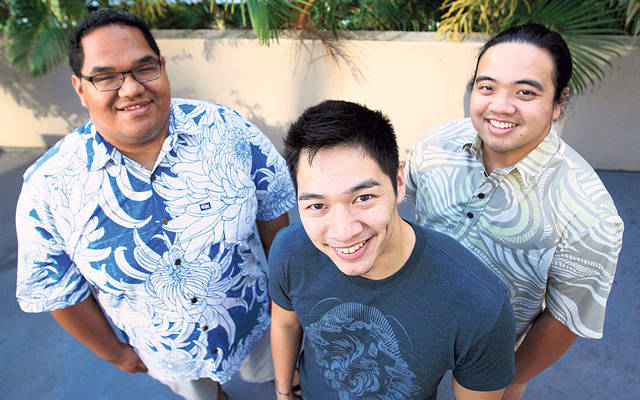Nick Lum got the news from his mother, who’d gotten a call from another member of Keauhou, his Hawaiian music trio: Their self-titled debut album had not only made the final ballot for this year’s Na Hoku Hanohano Awards, it was also the overall leader with a total of 12 nominations across nine categories.
“She wakes me up at, like, 7 o’clock — I don’t get up that early — and she said, ‘Keauhou got 12 nominations,’ and then she showed me the (newspaper),” Lum said last week.
At 23 he is the youngest member of the trio. His brother, Zachary “Zach” Lum, and Jonah Solatorio are 25. All three are graduates of Kamehameha Schools and the University of Hawaii at Manoa. All three speak Hawaiian. And all three are nominated individually in the prestigious Haku Mele category that honors excellence in Hawaiian-language songwriting.
Lyrics have been the foundation of Hawaiian music since pre-contact times. The methods used in composing lyrics are far more elaborate than simply finding the right rhyme to end each line. Appreciating a lyricist’s skill requires knowledge of the classical techniques in addition to fluency in the language.
Because of this, Haku Mele winners are determined by adjudicators selected for their demonstrated understanding of Hawaiian poetic techniques, their general fluency and their integrity.
2017 NA HOKU HANOHANO AWARDS
>> Where: Kalakaua Ballroom, Hawaii Convention Center
>> When: 5 p.m. Saturday
>> Cost: $175 general admission, $150 kamaaina, $135 HARA members, $250 premium
>> Info: 593-9424, nahokuhanohano.org
>> Note: The Na Hoku Hanohano Awards will be broadcast live at 7 p.m. Saturday on KFVE The Home Team and live-streamed here. Immediately following the awards ceremony, find a complete list of winners on our website.
“That’s definitely something we are very proud of, to be recognized by those specific people,” said Zach Lum. “Some of them are people we’ve learned from.”
Added his brother, “Of all the nominations, the thing that stood out to me the most was the three Haku Mele nominations. I’m really proud of that.”
Zach’s Haku Mele song, “Hanohano Ha‘iku,” a poetic description of the place where he grew up, is also a finalist for song of the year. As author of the album’s detailed liner notes, he is a finalist in that category as well.
“I value the liner notes a lot,” Lum said. “It comes from the days of the (vinyl) albums to where they’ve become like cultural resources with the work of (liner notes writer) Kini Sullivan. If it gets recognized, if it doesn’t get recognized, I just know that there’s a lot of aloha that went into it.”
COMING AROUND AGAIN
The “aloha” extends to the vast majority of Hawaiian music fans who aren’t fluent in the native language. The liner notes explain that Nick Lum’s nominated composition, “Pikake Launa ‘Ole,” describes one’s beloved as a sweetly fragrant pikake lei in the evening, and that “Kahiko Kapalama” expresses Solatorio’s feelings for Kamehameha Schools by describing its location.
“There too is where we grew a passion for music, and for me language as well,” said Solatorio, who plays ukulele in the group. “I wanted to honor that place where we all grew up and where we acquired that passion.”
Guitarist Zach Lum explained that the name of the trio is constructed around two meanings of the word “hou”:
“‘Hou,’ like in ‘hana hou,’ is ‘again,’ but ‘hou’ also means ‘new.’ So ‘renewed’ and ‘new’ are the same word. And so because of that, it has this cyclical idea of what time is. … We’re trying to inject ourselves into this ‘old thing’ that already has come around the block and will come around the block again.
“The concept of ‘new’ and ‘renewed’ is a big one for us.”
CALIFORNIA CALLS
Keauhou seemed on the verge of breaking out as recording artists when an earlier version of the group — Solatorio, Zach Lum and two others — won the prestigious Ka Himeni ‘Ana unamplified Hawaiian singing contest in 2008. The winners’ prize was a record deal that “didn’t pan out.”
“In 2008 we were juniors,” said Zach Lum. “It was nice (to win) but I’m glad we did wait to record. I guess there was just a lot of other stuff happening in life at that time: High school. Graduating. Going to college. Figuring out that whole different lifestyle.”
Lum and Solatorio continued making music together. Nick Lum became the third voice and the group’s bass player. And then, as the narrators of old would say, opportunity knocked.
Famed Hawaiian entertainer and kumu hula Robert Cazimero presented the two Lums as his guests in a show at California’s Whittier College. The school’s theater manager, Shane Cadman, learned that the brothers had their own group and invited them to come back and headline their own show.
“We were thinking, ‘We don’t even have a CD, we don’t have anything,’ but he said it would be good to feature new artists,” Nick Lum recalled.
Thinking it would be “shame” to headline a concert and not have a CD of their work, they recorded four of their own compositions and 12 of their favorite standards for “Keauhou,” and now have a solid chance at bringing home several Na Hoku awards for the effort.
“I think it was a long-time-coming project but we just needed that kick to finally press the button,” Nick Lum said.
TEACHING OTHERS
The elder Lum brother teaches at Kamehameha and is the school’s director of choral music, a position of tremendous responsibility given the importance of choral music there since the school was founded almost 130 years ago. He is also involved in a new multidisciplinary music program that combines music with recording and video production.
Solatorio teaches Hawaiian at Kamehameha, a career choice he came around to while he was in college.
“When I was growing up I never had a desire to be a teacher, but after graduating and choosing what I wanted to do for my master’s, I realized it’s important for us to teach what we learned from all of our teachers, whether it be language or music.
“I’m glad I’m on this path of teaching now.”
Nick Lum lost his job as a UH graduate assistant when he graduated Friday. He said he “plans to be unemployed this summer and rest my brain,” but has job applications out and plans to be a teacher.
Sometime soon they’ll start work on their next album.
“I’d like to start in June,” Nick said.
“I’d like to start tomorrow,” Zach replied with a sigh, “but there’s no time.”
2017 NA HOKU HANOHANO AWARDS FINALISTS
>> Album of the year
1. “E Walea,” Kalani Pe‘a (Kalani Pe‘a Music)
2. “He Leo Huali: ‘A Pure Voice,’” Ra‘iatea Helm (Ra‘iatea Helm Records)
3. “Hi‘ilawe,” Cyril Pahinui (Pahinui Productions)
4. “Keauhou,” Keauhou (Keauhou)
5. “Ku‘u Pua Sakura,” Hoku Zuttermeister (Kaleiola Records)
>> Male vocalist of the year
1. Kawika Kahiapo, “Uke Can Call Me Cousin” (Pono Records)
2. Cyril Pahinui, “Hi‘ilawe” (Pahinui Productions)
3. Kalani Pe‘a, “E Walea”(Kalani Pe‘a Music)
4. Josh Tatofi, “Pua Kiele” (Bu-Print Records)
5. Hoku Zuttermeister, “Ku‘u Pua Sakura” (Kaleiola Records)
>> Female vocalist of the year
1. Amy Hanaiali‘i, “Remembering Napua” (Ua Records)
2. Ra‘iatea Helm, “He Leo Huali: ‘A Pure Voice’’’ (Ra‘iatea Helm Records)
3. Maggie Herron, “Between the Music & the Moon” (Herron Song
Records)
4. Mailani, “Alo i ke Alo” (Ha Enterprises)
5. Yoza, “Prologue” (Yoza Music)
>> Group of the year
1. Keauhou, “Keauhou” (Keauhou)
2. Komakakino, “E Nipo Mai” (The Lahui Project)
3. Ron Kualaau & Zanuck Lindsey, “Koko” (Kapala Music Group)
4. Kupaoa, “Ho‘okele” (Hulu Kupuna Productions)
5. A Touch of Gold, “Whenever You Come Around” (Kuleana Breakfast Club)
>> Most promising artist of the year
1. Aja Gample, “Hua‘i” (Aja Gample)
2. Izik, “Obsidian” (Zeo Music)
3. The Kaimana Band, “The Moment” (Kaimana Music)
4. Keauhou, “Keauhou” (Keauhou)
5. Kolomona Ku, “Fountain After the Drought” (808 KO Music)
6. Kalani Pe‘a, “E Walea” (Kalani Pe‘a Music)






